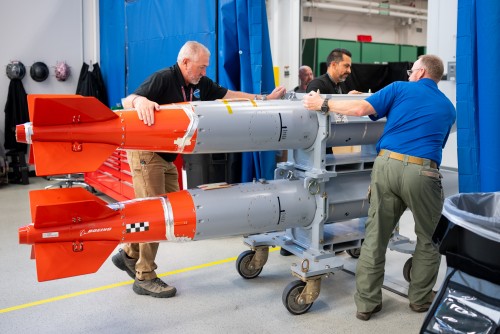After more than a decade of painstaking development and production, the U.S. nuclear security enterprise has quietly reached a pivotal milestone. In December, workers at the Pantex Plant completed the final production unit of the B61-12 nuclear gravity bomb, transitioning the weapon system fully into stockpile sustainment.
The completion represents the culmination of one of the nation’s most complex nuclear modernization efforts, extending the service life of a weapon first deployed during the height of the Cold War by at least two decades.
“It’s a tremendous accomplishment,” said Rich Otten, a Sandia National Laboratories senior manager involved in the design and production aspects of the B61-12 Life Extension Program. “For more than a decade, people have poured their time, effort and careers into making this a reality.”
While the final production unit milestone has been reached, program officials note that spare components are still being manufactured, with closeout activities continuing into fiscal year 2026.
The B61-12 program stands as a testament to interagency collaboration, bringing together expertise from across the national security landscape. The multi-year effort required seamless coordination between Sandia and Los Alamos national laboratories, the Kansas City National Security Campus, Pantex Plant, Y-12 National Security Complex, Savannah River Site, the National Nuclear Security Administration (NNSA), and the U.S. Air Force, along with numerous private sector vendors.
Originally entering service in 1968, the B61 has undergone several modifications throughout its operational history. This latest life extension program has replaced most older variants, resulting in what officials describe as a “high reliability stockpile.”
As systems integrator for the B61-12, Sandia National Laboratories shouldered responsibility for ensuring all components and subsystems functioned cohesively. The laboratory served as the design and engineering center for the weapon’s non-nuclear components.
Otten emphasized the complexity of the production process, particularly regarding aircraft compatibility. “Significant effort went into ensuring aircraft compatibility, especially as changes were made to delivery platforms,” he noted.
From Production to Sustainment
With production now complete, attention shifts to the equally critical task of maintaining the weapon’s readiness and reliability throughout its extended service life.
“We want to take time to recognize and celebrate the last production unit,” said Scott Klenke, a Sandia senior manager overseeing stockpile sustainment. “This is just the beginning of our efforts at Sandia to make sure the B61-12 is sustained and maintained appropriately. It’s a critical element to ensure we have a strong and viable deterrent.”
The transition to sustainment initiates a new phase of comprehensive monitoring and assessment. Units will be randomly selected from the stockpile and disassembled at the Pantex Plant, with components undergoing rigorous testing at Sandia’s Weapons Evaluation Testing Laboratory.
Some units will be allocated for surveillance flight tests, generating crucial performance data. Information gathered through these surveillance activities directly supports the system’s annual assessment report, which serves as the foundation for the Laboratories director’s formal certification of stockpile safety and reliability.
“These surveillance and assessment activities continue until retirement and until the last unit is dismantled,” Klenke explained.
Throughout the production phase, Sandia manufactured several specialized components that were delivered to the Kansas City National Security Campus and Pantex Plant, enabling full-scale production operations.
Implications for Nuclear Deterrence
The completion of the B61-12 program comes at a time of renewed global focus on nuclear arsenals, with several nuclear powers actively modernizing their capabilities. For the United States, maintaining a credible nuclear deterrent involves not just developing new systems but also extending the operational life of existing weapons through programs like the B61-12.
Defense analysts note that gravity bombs represent a crucial element of nuclear deterrence strategy, offering flexibility that other delivery systems may lack. Aircraft-delivered weapons can be deployed, recalled, or redirected in ways that missile-based systems cannot, providing military planners with additional options during periods of heightened tension.
The success of the B61-12 life extension program demonstrates the technical competence of the U.S. nuclear enterprise at a time when such capabilities are increasingly viewed as critical to national security.
As the B61-12 enters its sustainment phase, engineers and scientists across the nuclear security complex will continue their behind-the-scenes work maintaining these sophisticated systems – an ongoing, methodical effort that rarely makes headlines but remains essential to U.S. strategic posture.
The transition from production to sustainment, while appearing straightforward, involves intricate processes to ensure the weapons remain safe, secure, and reliable over their extended operational lifespan – a commitment that will continue for decades to come.
If our reporting has informed or inspired you, please consider making a donation. Every contribution, no matter the size, empowers us to continue delivering accurate, engaging, and trustworthy science and medical news. Independent journalism requires time, effort, and resources—your support ensures we can keep uncovering the stories that matter most to you.
Join us in making knowledge accessible and impactful. Thank you for standing with us!

